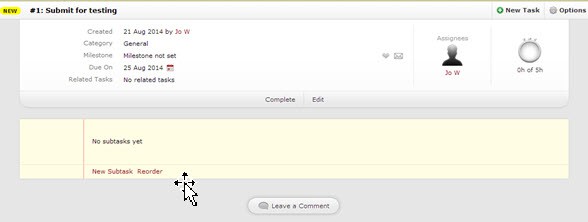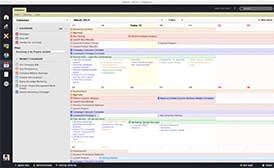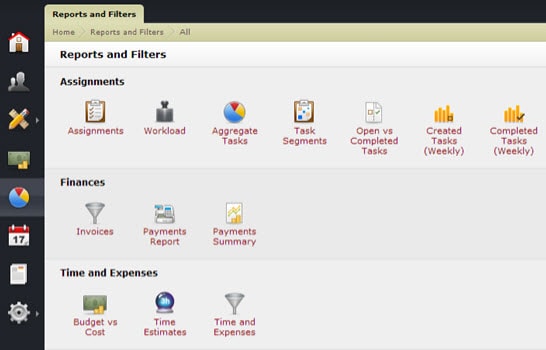Software review: activeCollab
Read our review guidelines.
 General information
General information
Name: activeCollab
Vendor: A51
Hosting options: Web hosted and locally hosted
Cost: From $25 for a small cloud hosted option to $2999 a year for a mega cloud option, and reasonable locally hosted prices too.
Languages:English as standard with the option of downloading German, French, Spanish, Portuguese, and Swedish. Plus you can translate it into your own language if you want following the documentation and you can set languages at user level – very helpful for managing an international team.
Currency: 5 standard currencies (GBP Pound, US Dollar, Canadian Dollar, Euro, Yen) but you can create any other currencies that you want with a few clicks.
Basic features: creating projects, tasks and people
Creating a new project is easy via the Projects tab. Click on ‘New Project’ and fill out the project form. You can specify the leader, category (adding a new category from this screen if the one you want isn’t in the list – thankfully not having to click out and go to settings first), client, budget and currency. Only Leader and Client are mandatory. Leader, I assume, is the project manager – maybe this terminology change is a nod to the current trend in the project management arena to talk about project leadership? Once created, the Project homepage gives you a summary of recent activities, along with project details on the right.
It’s easy to set up tasks in activeCollab but you can’t set up recurring tasks as standard. If you host the product on-premise, you can buy an add-on which gives you this, but I’m not sure that it would work with the online version. In fact, this is a recurring theme for extra bits. There are a number of good add-ons which I imagine many users would want. What would be really helpful is a note on the sales page of telling you whether all the add-ons will work with the online, cloud hosted packages.
OK, back to creating tasks. From the Project homepage you can click on the Tasks header and create a new task. The form looks similar to the Project tab and you can add a category (adding a new one if it isn’t in the dropdown), priority level, visibility (normal or private), due date, estimate in hours or minutes (there are default numbers but you can add new ones if you regularly have a job that may take, say, 50 hours to complete). You can also say what job type is required for the task eg programming or support (but you can’t add new types from here) and label it and add people to the Project. There is also the opportunity to set a Milestone if you have suitable tasks available. You can also create tasks in activeCollab by using Gmail or
As you can see, there is a lot of flexibility and customisability available. It’s the same with resources. You can invite people to the system by email and assign them different roles such as Admin, Manager, Member/Employee, Subcontractor and Client. I like how you can give clients access with limited permissions but it means that they can be involved in discussions within the system where appropriate. When inviting a new person you can personalise the welcome message, which is especially important for outside stakeholders who might routinely delete spam-like mails. There are default permissions for the different roles, but you can override them which gives the feeling of granular control.
Viewing your project
This is where the product fell down for me. I know I have reviewed other project management software tools in the past that don’t have a Gantt chart but I just thought activeCollab was so good it deserved to have a Gantt chart available. It seems a bit strange because there is a nice Timeline view available which is effectively a Gantt chart but it is only there to give you a portfolio level overview of all projects and it can’t be used within a project – shame. There is also a milestone chart which looks a bit like a Gantt chart in terms of layout. Having said that, the calendar view isn’t bad at all and it is nice to look at and easy to use. You can drag things around on the calendar which makes it very flexible and many project team members would probably prefer that to a Gantt chart.
The alert feature is also very good: it works as you would expect or you can turn off email alerts. The alternative (if you want them) is ‘notifications’. This feature is designed so that you choose when to read your messages without it interrupting your work and they just sit at the bottom of your screen.
If you do get stuck there is lots of help online via user manuals, guides and videos. They also have live chat and email support – though when I tried live chat at 7pm on a Sunday evening it sent an email – to be honest I wasn’t expecting them to be there.
Within each project you can raise a new discussion which you can either select to go out to the project group or individuals on the project. It can be pinned to the top. Discussions can be grouped by type/read/category/milestone. You can also favourite a discussion if you don’t want to miss something.
Clever reporting and financial features
There are lots of reports that will help you monitor workload and review assignments in different ways. You can configure a report and then save it for future use if there isn’t one out of the box that does exactly what you want. The reports are nice to look at with graphs where it is possible to display the data in that way. Some also have the option to export the data, but a few don’t.
Financial reporting and management is a strength of activeCollab. You can log time in timesheets and state whether it’s billable or not billable and there is a timer app to download which starts and stops as you’re working. You can also do all the stuff you would expect for managing project budgets and expenses including a budget vs cost report.
There is the additional feature to send invoices. This may be useful for a small company but most established businesses use some sort of accountancy package to send invoices. I can’t see how I’d export these invoices for use in another system, but there is an API and it might be covered by that. You don’t have to link the invoice to a project and what is generated is good. If I want resources to submit time against projects for which I am going to bill (in arrears), I can see how the invoice functionality could be used. Hourly rates are set on a project level by job type. For invoicing if I have done 10 hours of programming at £30p/h I’d expect to be able to run a ‘uninvoiced’ report with the ability to click a button and invoice – I couldn’t see how to do this. The invoicing features are not something I would personally use but they are obviouly important to some clients and there is a payment gateway for receiving money so if you did use this feature you could tie it all together neatly. Great for small businesses and freelancers, less useful probably for enterprise deployments.
In summary…
I had high hopes for activeCollab. It has been around for 6 years (the online version for a year) and I had heard many good things about it. It looks lovely – professional yet still cool. Terminology and navigation both work well. But it seems like there is out-of-the-box functionality that is missing… Historically activeCollab has been hosted locally, and other businesses have worked with the company to provide Add-ons and extensions. If you host your own activeCollab installation and need extras like MS Project compatibility or system audit trails, you can buy the functionally via a third party and it will integrate within your system. Several add-ons are free for cloud users whereas hosted users have to pay.
In summary I think this is a small price for a system that is ultimately very configurable, very useable and feature-rich. Recommended.



